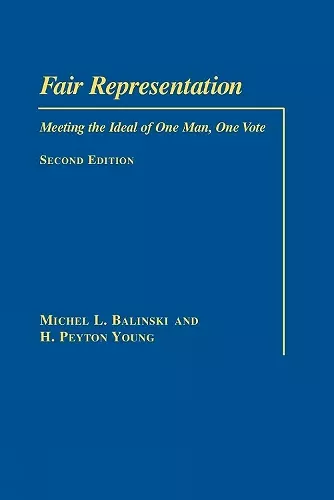Fair Representation
Meeting the Ideal of One Man, One Vote
H Peyton Young author Michel L Balinski author
Format:Paperback
Publisher:Bloomsbury Publishing PLC
Published:1st Sep '01
Currently unavailable, and unfortunately no date known when it will be back

"The definitive account-and solution-of the 200-year-old apportionment problem. The book is political analysis at its best Edward Tufte, Yale University" --Edward Tufte, Yale University, 1/11/2001
The issue of fair representation will take center stage as U.S. congressional districts are reapportioned based on the 2000 Census. Using U.S. history as a guide, the authors develop a theory of fair representation that establishes various principles for translating state populations —or vote totals of parties —into a fair allocation of congressional seats.The issue of fair representation will take center stage as U.S. congressional districts are reapportioned based on the 2000 Census. Using U.S. history as a guide, the authors develop a theory of fair representation that establishes various principles for translating state populationsor vote totals of partiesinto a fair allocation of congressional seats. They conclude that the current apportionment formula cheats the larger states in favor of the smaller, contrary to the intentions of the founding fathers and compromising the Supreme Court's ""one man, one vote"" rulings. Balinski and Young interweave the theoretical development with a rich historical account of controversies over representation, and show how many of these principles grew out of political contests in the course of United States history. The result is a work that is at once history, politics, and popular science. The bookupdated with data from the 1980 and 1990 Census countsvividly demonstrates that apportionment deals with the very substance of political power.
"The definitive account-and solution-of the 200-year-old apportionment problem. The book is political analysis at its bestEdward Tufte, Yale University" Edward Tufte, Yale University, 1/11/2001
ISBN: 9780815701118
Dimensions: 228mm x 151mm x 14mm
Weight: 331g
192 pages
2nd edition